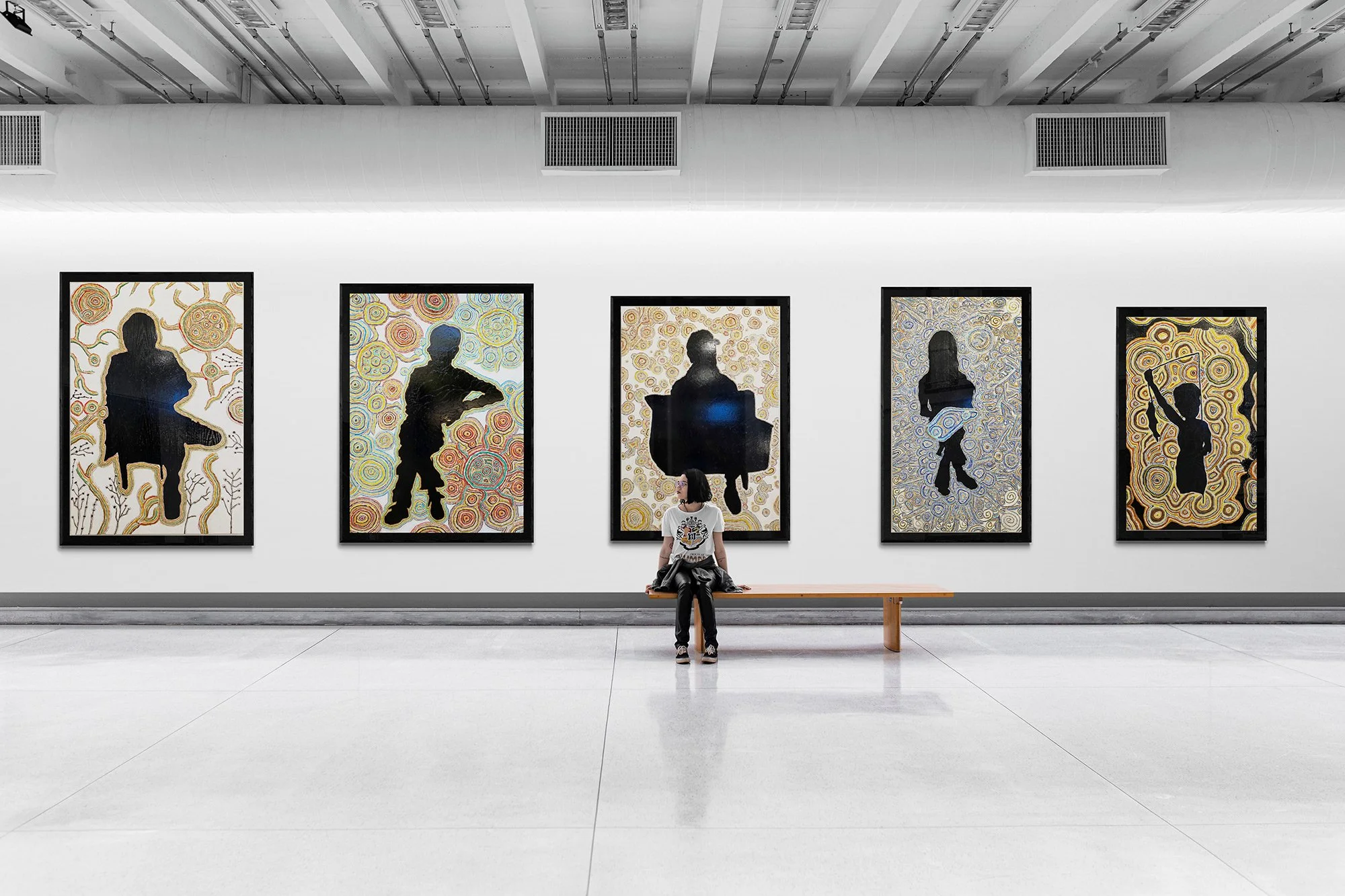Black Holes 2022-
The Black Holes are a type of universal portraiture, in a sense. Silhouetted figures immersed in tactile, mandala-like environs. The physical effect is similar to diaramas, ideally they transport you into the living vitlalilty of the painting. IRL, the figures are recessed into the piece, giving a physical dimensionality. They merge portraiture and abstraction to powerful, contemplative effect. — Steve Sas Schwartz
How Steve Sas Schwartz Challenges The History of Painting in The Black Holes Series — by Mat Gleason
Steve Sas Schwartz has turned the traditional painted portrait on its head in his BLACK HOLES series (2022). In an art historical lineage where he stands as the first, SAS has inverted centuries of what painting is expected to do.
This series depicts figures painted as an empty mass of dark-ness. Meanwhile the space around them is an active area of compositional logic and energetic interaction. For all of art history, this has been mostly ambivalent real estate, a place to hang the local flag or toss in a portrait of a pet dog or two. But SAS makes the space around the portrait subject the vibrant, thriving pictorial space. He then obliviates our expectations of what a painting can be by obliterating the subject.
There are two undercurrents in these pictures that the artist may be more intuitively than consciously connected to. The first is how these works actually mimic the way the universe as we currently understand it works. There are vast arrays of galactic activity that feed on one another. No matter how intricate and majestic they all are, though, every one of them will, as we currently understand it, succumb to being part of a black hole. Black holes are the cold empty centers of the physical universe. They are a manifestation of death, of tearing apart galaxies, of light succumbing to dark.
Instead of painting star fields orbiting shadowy spheres, SAS gives us a fresh meditation on the energy abounding around a subject without fixating on that subject. A second consideration of the work is more topical. The current vogue for what is called cancellation does not exist in a vacuum. SAS does not have to paint a portrait of Harvey Weinstein or even allude to him to make paintings that reflect an era where one’s whole known social persona is instantly and often irrevocably blackened into a void. The universe still interacts with all its majestic energy around the canceled person, their influence and their legacy, but they themselves have been sucked into a social black hole, gone for good, or what the scolds on earth would assert is the greater good.
The painting style in the BLACK HOLES series is raw and assertive, direct enough to be a little messy but expressionistic enough to turn the viewer on toward appreciating that which surrounds the central subjects in our lives.
Migration
2012 / 2022, 109” x 57 1/2”, acrylic, gels, modeling paste, alkyd enamel, charcoal on wood
Joy Pawns
2012 / 2022, 47 1/2” x 99 1/2” acrylic, gels, modeling paste, alkyd enamel, charcoal on wood
Chat (don’t know where I’m going but know exactly how to get there)
2022, alkyd enamel, blister packs, acrylic, 58” x 60”
Kali (yes i have a mistress, her name is art, she screws me all the time😂 😅🤣)
2022, blister packs, acrylic, cement, alkyd enamel, 47.75” x 67.5”
Strung Out
2022, 48” x 32”, mixed-media on wood.
Ridin’ ridin’
2022, 48” x 68”, mixed-media on wood.
Drift
2012 / 2022, 49 1/2" x 77 1/2”, gels, acrylic, alkyd enamel, modeling paste on wood
Bad Motor Scooter
2022, alkyd enamel on wood, 49.5” x 48”
Yoga
2022, mixed-media on wood, 54” x 47.5”
detail.
Architect
2014 / 2020, 68 1/4” x 48 1/8”, mixed-media on wood.
Lawyer
2014 / 2020, 60” x 41 1/8”, mixed-media on wood.
Psychologist
2014 / 2020, 62” x 43 1/4”, mixed-media on wood.
Mother and Daughter
2014 / 2020, 65” x 36 1/4”, mixed-media on wood.
Ancestor
2014 / 2020, 57 1/4” x 39 1/2”, mixed-media on wood.





























